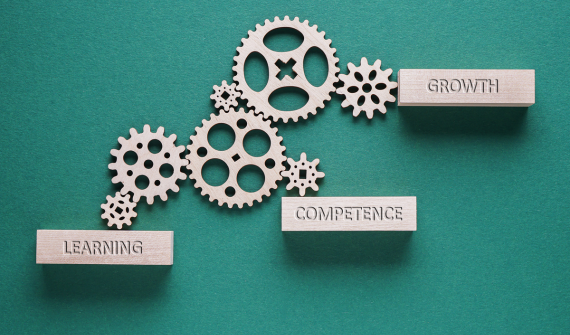What Is Competency Based Training and How to Implement it?
Competency Based Training (CBT) is a learner-centered approach that focuses on developing specific skills, knowledge, and abilities required for job performance.
This comprehensive guide explores the concept of Competency Based Training and provides insights into its benefits and implementation strategies within your organization.
Discover how CBT can revolutionize your training programs, align them with organizational goals, and empower your workforce to excel in their roles.
What Are Competency Based Training Programs?

Competency Based Training programs are educational and training initiatives designed to develop and assess specific skills, knowledge, and abilities required for effective job performance.
Unlike traditional training programs that focus on time-based completion, CBT emphasizes mastery of competencies.
These programs define a set of clear learning outcomes and competencies, allowing learners to progress at their own pace based on their demonstrated abilities.
Competency Based Training programs provide targeted and personalized learning experiences, enabling individuals to acquire the necessary skills and competencies needed to succeed in their roles.
How To Implement Competency Based Training?

Implementing Competency Based Training (CBT) in your organization involves several key steps:
1. Identify Competencies
Identify the key competencies required for each job role or function within your organization.
Consult with subject matter experts and stakeholders to define the specific skills, knowledge, and abilities needed for success.
2. Develop Learning Outcomes
Clearly define the learning outcomes for each competency. Specify what learners should be able to do or demonstrate upon completion of the training program.
These outcomes should be measurable and aligned with organizational goals.
3. Design Learning Experiences
Design learning experiences that focus on developing and assessing the identified competencies.
Utilize a variety of instructional methods such as e-learning modules, simulations, on-the-job training, or mentorship programs to cater to different learning styles and preferences.
4. Assess Learner Performance
Implement assessments and evaluations to measure learner performance and progress toward the identified competencies.
Use a mix of formative and summative assessments, such as quizzes, projects, practical demonstrations, or performance evaluations, to gauge mastery levels.
5. Provide Personalized Learning Paths
Tailor learning paths based on each learner's existing competencies and individual needs.
Offer flexible learning options that allow learners to progress at their own pace and focus on areas that require improvement.
6. Offer Continuous Feedback And Support
Provide ongoing feedback and support to learners throughout their competency-based training journey.
Offer coaching, mentoring, or additional resources to help learners overcome challenges and enhance their competencies.
7. Evaluate And Iterate
Continuously evaluate the effectiveness of the CBT program by analyzing learner outcomes and gathering feedback from participants.
Use this data to make necessary adjustments, refine the program, and improve future iterations.
8. Foster A Culture Of Competency Development
Promote a culture that values competency development and continuous learning.
Encourage employees to actively engage in CBT opportunities and provide recognition and incentives for their achievements.
By following these steps, you can successfully implement Competency-Based Training in your organization, enabling employees to acquire the necessary skills and competencies to excel in their roles and contribute to organizational success.
Competency-Based Training Examples

Here are a few examples of Competency-Based Training (CBT) in different industries:
1. Healthcare
In healthcare, CBT can be used to train medical professionals on specific clinical procedures or skills, such as administering injections, conducting patient assessments, or performing surgical techniques.
The training focuses on competency mastery and includes hands-on practice, simulations, and assessments to ensure proficiency.
2. Information Technology
In the IT industry, CBT can be employed to develop technical competencies.
For example, training programs can be designed to help IT professionals gain proficiency in programming languages, cybersecurity practices, network administration, or cloud computing.
Learners are assessed on their ability to apply their knowledge in practical scenarios.
3. Customer Service
Competency Based Training courses can be utilized to enhance customer service skills.
Training programs may include competencies such as active listening, problem-solving, conflict resolution, and effective communication.
Learners engage in role-plays, scenario-based simulations, and real-life customer interactions to develop and assess these competencies.
4. Leadership Development
CBT is valuable for leadership development programs. It focuses on developing competencies such as strategic thinking, decision-making, team management, and communication skills.
Learners participate in workshops, case studies, and leadership projects to enhance their leadership competencies and demonstrate their proficiency.
5. Sales And Marketing
Competency-Based Training can be applied to sales and marketing teams to develop skills such as prospecting, negotiation, relationship building, and product knowledge.
Training programs may include simulations, role-plays, and sales scenarios to allow learners to practice and demonstrate their competencies in realistic sales situations.
These are just a few examples of how Competency Based Training courses can be implemented in various industries.
The approach allows organizations to focus on specific competencies crucial for job success and ensures that learners acquire and apply those competencies effectively.
Differences Between Competency-Based Training & Traditional Training
Competency-Based Training (CBT) differs significantly from traditional training approaches in several key aspects:
1. Focus On Competencies
CBT places a strong emphasis on developing specific competencies or skills required for job performance.
It defines clear learning outcomes and concentrates on assessing mastery of those competencies.
In contrast, traditional training often focuses on delivering a fixed curriculum or covering a broad range of topics without emphasizing specific competencies.
2. Individualized Learning Paths
CBT offers personalized learning paths based on individual learner needs and existing competencies.
Learners can progress at their own pace, focusing on areas where improvement is needed.
Traditional training typically follows a standardized curriculum or schedule, with little flexibility for individual learning preferences or existing knowledge levels.
3. Mastery-Based Progression
CBT allows learners to advance once they have demonstrated mastery of the required competencies.
Learners can move on to the next level or topic when they are ready, irrespective of the time taken.
In contrast, traditional training often follows a time-based approach where learners progress based on fixed timelines, regardless of their mastery of the subject matter.
4. Authentic Assessments
CBT incorporates authentic assessments that measure learners' ability to apply knowledge and skills in real-world scenarios.
Assessments may include practical demonstrations, simulations, projects, or performance evaluations.
Traditional training tends to rely more on traditional testing methods like quizzes or written exams that may not fully reflect real-world applications.
5. Learner-Centered Approach
CBT places the learner at the center of the training process, focusing on individual needs, preferences, and progress.
Learners have more control over their learning experience and can actively engage in the training process.
Traditional training often follows a more instructor-centered approach, where the trainer delivers content and assessments without as much learner involvement.
6. Continuous Improvement
CBT promotes a culture of continuous improvement by regularly evaluating learner outcomes and refining the training program based on feedback and performance data.
Traditional training may have less emphasis on ongoing improvement and may rely on a fixed curriculum that remains unchanged for extended periods.
By understanding these differences, organizations can leverage Competency-Based Training to provide targeted, personalized, and effective learning experiences that lead to the mastery of essential job competencies and improved performance.
Revolutionize Workplace Learning With Oreed
Unlock a world of enhanced learning potential in your workplace with Oreed!
Our all-in-one education intelligence platform empowers you to optimize employee training and development through a range of powerful features.
1. Gain Comprehensive Insights With Oreed
With Oreed, you can gain a comprehensive understanding of your employees, enabling you to better gauge their unique training needs.
By leveraging valuable insights, you can make informed decisions and design targeted training programs that align with your organization's goals.
2. Tailor-Made Training And Courses
Say goodbye to generic, one-size-fits-all training programs. Oreed offers tailor-made training and courses specifically designed to fit your organization's specific requirements.
Whether it's job-specific skills, leadership development, or technical proficiency, Oreed enables you to deliver customized learning experiences that resonate with your employees.
3. Measure Training Effectiveness With Ease
Assessing the impact and effectiveness of your training is essential for continuous improvement.
Oreed's cutting-edge impact assessment feature allows you to measure the effectiveness of your training and courses with ease.
Monitor learner progress, evaluate outcomes, and gather valuable data to refine and optimize your training initiatives.
4. Embrace Personalized And Effective Workplace Learning
Oreed revolutionizes workplace learning by providing a more personalized and effective approach.
By tailoring training to individual needs and focusing on targeted competencies, you can maximize employee engagement, improve performance, and drive organizational success.
Experience a new era of workplace learning and empower your employees to thrive and excel in their roles.
So what are you waiting for? If you are planning to host an online event, book a demo with Oreed today and get a walk of all our features.
Promote lifelong learning through Oreed by experiencing the most powerful all-in-one training and development intelligent platform that streamlines all your organization's learning, training, and development activities in one place.
Final Thoughts
Competency-Based Training (CBT) is a powerful approach to employee development that focuses on specific skills, knowledge, and abilities needed for job success.
By implementing CBT in your organization, you can ensure that employees acquire and demonstrate the required competencies effectively.
Identify key competencies, design personalized learning paths, assess performance, and foster a culture of competency development.
Embrace CBT to enhance employee skills, improve performance, and drive organizational success through targeted and effective training initiatives.
FAQs
1. How do Competency Based Learning Outcomes enhance learner engagement and motivation?
Competency Based Learning Outcomes enhance learner engagement and motivation by providing clear goals and objectives.
Learners can see the practical relevance of their learning, understand the skills they are acquiring, and track their progress toward competency mastery.
This sense of purpose and progress can increase motivation and engagement in the learning process.
2. How can Competency Based Learning Outcomes be assessed?
Competency-Based Learning Outcomes can be assessed through a variety of methods, including performance assessments, project-based evaluations, simulations, portfolios, and practical demonstrations.
These assessments focus on the application and demonstration of acquired competencies, providing a more accurate reflection of learners' abilities.
Embracing Competency Based Learning Outcomes can revolutionize training and education by providing clear targets, personalized learning experiences, and practical skill development.
By aligning learning outcomes with specific competencies, organizations can drive employee success, enhance performance, and meet the evolving demands of the workforce.